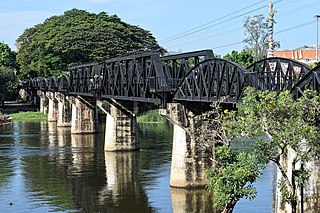 W
WThailand in World War II officially adopted a position of neutrality until the five hour-long Japanese invasion of Thailand on 8 December 1941 which led to an armistice and military alliance treaty between Thailand and the Japanese Empire in mid-December 1941. At the start of the Pacific War, the Japanese Empire pressured the Thai government to allow the passage of Japanese troops to invade British-held Malaya and Burma. The Thai government under Plaek Phibunsongkhram considered it profitable to co-operate with the Japanese war efforts, since Thailand saw Japan – who promised to help Thailand regain some of the Indochinese territories which had been lost to France – as an ally against Western imperialism. Axis-aligned Thailand declared war on the United Kingdom and the United States and annexed territories in neighbouring countries, expanding to the north, south, and east, gaining a border with China near Kengtung.
 W
WThe Anglo-Thai Peace Treaty signed in Singapore on 1 January 1946 ended the state of war that had existed between Thailand and the United Kingdom since the former's declaration of war of 25 January 1942 during World War II. Although the Thais had also declared war on the United States on the same day, a U.S.–Thai peace treaty was never signed because the American government opted not to recognise the legality of the declaration in light of the Japanese invasion of Thailand on 8 December 1941.
 W
WThe Burma Railway, also known as the Death Railway, the Siam–Burma Railway, the Thai–Burma Railway and similar names, is a 415-kilometre (258 mi) railway between Ban Pong, Thailand and Thanbyuzayat, Burma, built by the Empire of Japan from 1940–1944 to supply troops and weapons in the Burma campaign of World War II. This railway completed the rail link between Bangkok, Thailand and Rangoon, Burma. The name used by the Japanese Government is Thai–Men-Rensetsu-Tetsudou (泰緬連接鉄道), which means Thailand-Burma-Link-Railway.
 W
WThe Greater East Asia Co-Prosperity Sphere , or the GEACPS, was an imperialist concept which was developed in the Empire of Japan and propagated to Asian populations which were occupied by it from 1931 to 1945. It extended across the Asia-Pacific and promoted the cultural and economic unity of East Asians, Southeast Asians, South Asians and Oceanians. It also declared the intention to create a self-sufficient bloc of Asian nations which would be led by the Japanese and this bloc would also be free from the rule of Western powers. The idea was announced in a radio address which was titled "The International Situation and Japan's Position" and delivered by Foreign Minister Hachirō Arita on 29 June 1940.
 W
WThe Greater East Asia Conference was an international summit held in Tokyo from 5 to 6 November 1943, in which the Empire of Japan hosted leading politicians of various component members of the Greater East Asia Co-Prosperity Sphere. The event was also referred to as the Tokyo Conference.
 W
WThe Japanese invasion of Thailand occurred on 8 December 1941. It was briefly fought between the Kingdom of Thailand and the Empire of Japan. Despite fierce fighting in Southern Thailand, the fighting lasted only five hours before ending in a ceasefire. Thailand and Japan then formed an alliance, making Thailand part of the Axis' alliance until the end of World War II.
 W
WThe Lost Battalion was the 2nd Battalion, 131st Field Artillery, 36th Infantry Division of the U.S. Army. The men of the battalion, plus the survivors of the sunken Cruiser USS Houston, were captured by the Japanese on the island of Java in the Dutch East Indies in March 1942. It is called the lost battalion because the fate of the men was unknown to the United States until September 1944. They were prisoners of war for 42 months until the end of World War II. 534 soldiers from the battalion and 368 survivors of the Houston were taken prisoner. Most of the men were sent to Thailand to work on the Burma Railway, the building of which is portrayed in the film The Bridge on the River Kwai. Of the 902 soldiers and sailors taken captive, 163 died in captivity. Most of the prisoners of war were from western Texas.
 W
WOperation Krohcol, or the Battle for The Ledge, was a British operation in December 1941 to invade southern Thailand following the Japanese invasion of Malaya and of Thailand during World War II. It was authorised by Lieutenant-General Arthur Percival as a "mini Matador" after Operation Matador, a pre-emptive strike into Thailand which had been opposed by the British government and was not carried out. Due to delays in authorisation by Percival and in the forwarding of his order, the need to reorganise the troops for Krohcol instead of Matador, and resistance from Thai policemen the Krohcol column did not reach the Ledge in time.
 W
W